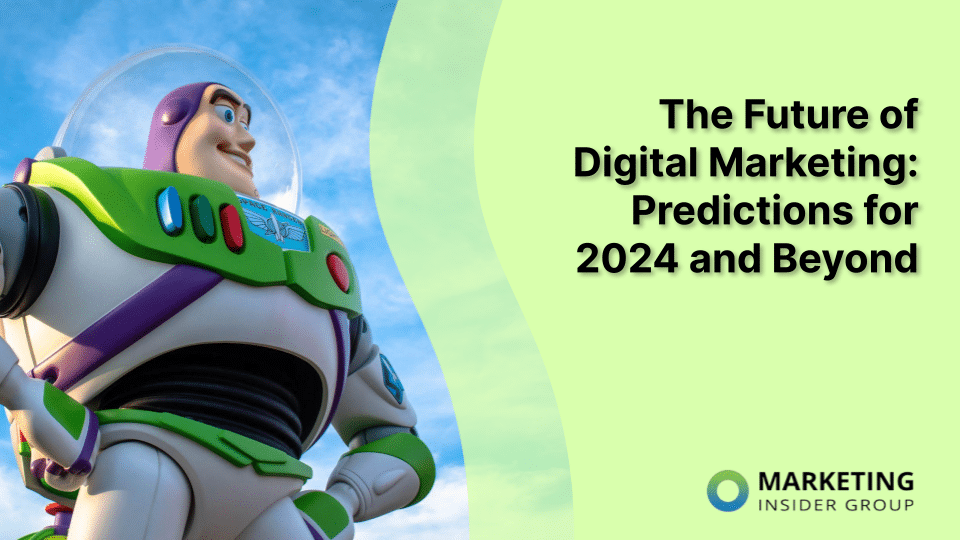
The Future of Digital Marketing: Predictions for 2024 and Beyond
The digital marketing landscape is always changing, with new tools, trends, and tech popping up left and right. It’s a lot, especially for site owners trying to keep pace with all these changes. But hey, that’s where we come in.
We’re exploring the future of digital marketing to give you the lowdown on what’s hot for 2024 and beyond. So, buckle up and get ready for a sneak peek at the trends that are set to shake things up. Trust us, you don’t want to be left playing catch-up.
Quick Takeaways
- Content marketing has made a powerful comeback, with 61% of marketers expecting better performance in 2024 due to its crucial role in SEO.
- AI is rapidly advancing, challenging us to rethink content quality and purpose as it increasingly assists in content creation.
- Voice-activated technology, such as smart speakers and assistants, is thriving in 2024, offering unique marketing opportunities and innovative advertising strategies.
- Video content is king, comprising over 82% of internet traffic, driving engagement, and generating leads in 2024, especially with the integration of live video and augmented reality.
What’s Hot in 2024? 3 Digital Marketing Trends You Can’t Ignore
As we dive into 2024, there’s three big waves making a splash in digital marketing. Trust us, you’ll want to surf these trends.
1. Content Marketing’s Big Comeback
Remember when everyone was throwing cash at social media ads to get noticed? Well, times have changed. Now, it’s all about content marketing.
Why the shift? Simple. Google told us that high quality content is key for climbing those search rankings. The proof: 61% of marketers are expecting better business performance this year, and 41% are cranking up their content budgets.
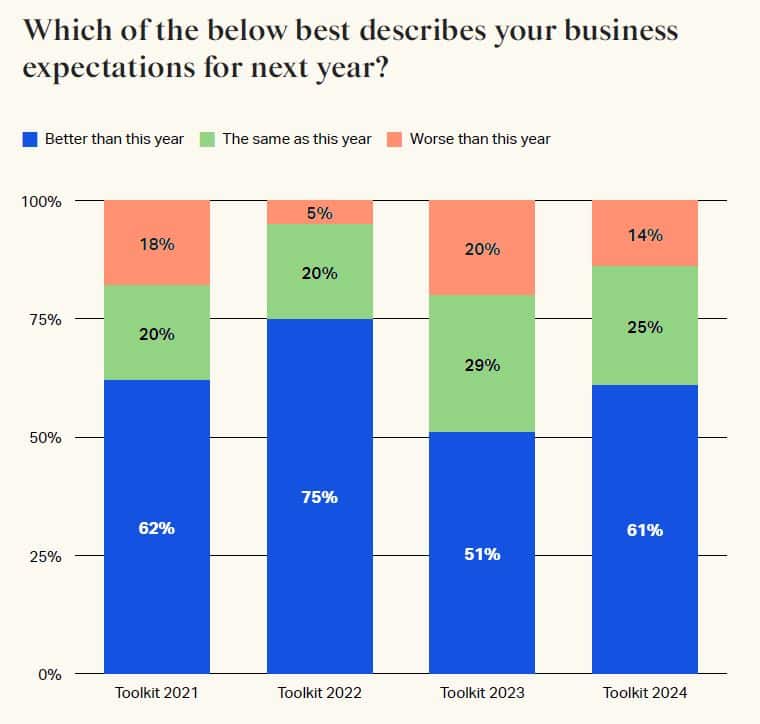
Image Source: WARC
So, content isn’t just making a comeback; it’s the main event.
2. AI-Generated Content
Imagine having a robot sidekick crafting content. Sounds neat, right? Well, it’s happening. While we’re not at the point where AI is penning Pulitzer-worthy blogs, the tech is getting there, fast.
Major outlets have been using AI for the basic stuff, but the horizon is promising for more complex pieces. It’s a brave new world where AI nudges us to rethink content quality and purpose.
3. Employee Activation
AI might be the brains behind what content to create, but guess what? Your team is the heart. That’s right, your employees are your ace storytellers, ready to be the voice and vibe of your brand.
It’s time to empower them to create and share content like never before. We call it The Paradox of AI: the smarter the tech, the more we need human creativity and connection.
But that’s not all. Read on to learn more about trends on the horizon that are reshaping how we connect, create, and convert in 2024.
Voice-powered Everything
Smart speakers and “assistants” have been a staple in homes for several years, with their popularity surging around 2017 and 2018 as consumers became more comfortable interacting with devices like Amazon Alexa and Google Home.
This trend has not only stuck around but expanded, with voice-activated technology becoming a standard mode of interaction with digital devices. By 2024, it’s said that the proportion of voice search queries has continued to rise, now accounting for a significant majority of all searches.
The integration of voice search into smart devices has opened new avenues for marketers, providing unique opportunities to reach consumers through these platforms. Amazon, an early adopter of leveraging its devices for marketing, has set a precedent that others have followed, innovating with targeted advertising through voice-activated assistants.
As voice search technology becomes more ingrained in consumer habits, the potential for marketing through these channels has grown. Brands are increasingly exploring ways to integrate voice search into their digital marketing strategies, recognizing the importance of being present in the voice-activated ecosystem to capture the attention of users in this growing segment.
AI-Powered Marketing and Support Technology
Artificial intelligence has been expanding what’s possible in the future of digital marketing for quite a while now. We’ve watched AI grow from a tech buzzword to a powerhouse, and now, in 2024, it’s doing things we only dreamed of a few years back.
Chatbots aren’t just an option anymore; they’re the new normal. They’ve gotten so good at mimicking humans, it’s almost eerie. They’re handling customer service like pros, freeing up our teams to focus on the big picture stuff. It’s all about making conversations with customers easy as pie, without burning out our staff.
And let’s talk about AI in advertising. We know AI can’t match human creativity, but it can make our jobs easier. Google’s been leading the charge, using AI to fine-tune ads so they hit the mark every time, based on how you and I react.
The Future of Social Media
You may think social media is already pervasive, but it still has room to grow. In 2024, 40% of marketers are prioritizing paid ads on social media, while 36% are prioritizing organic.
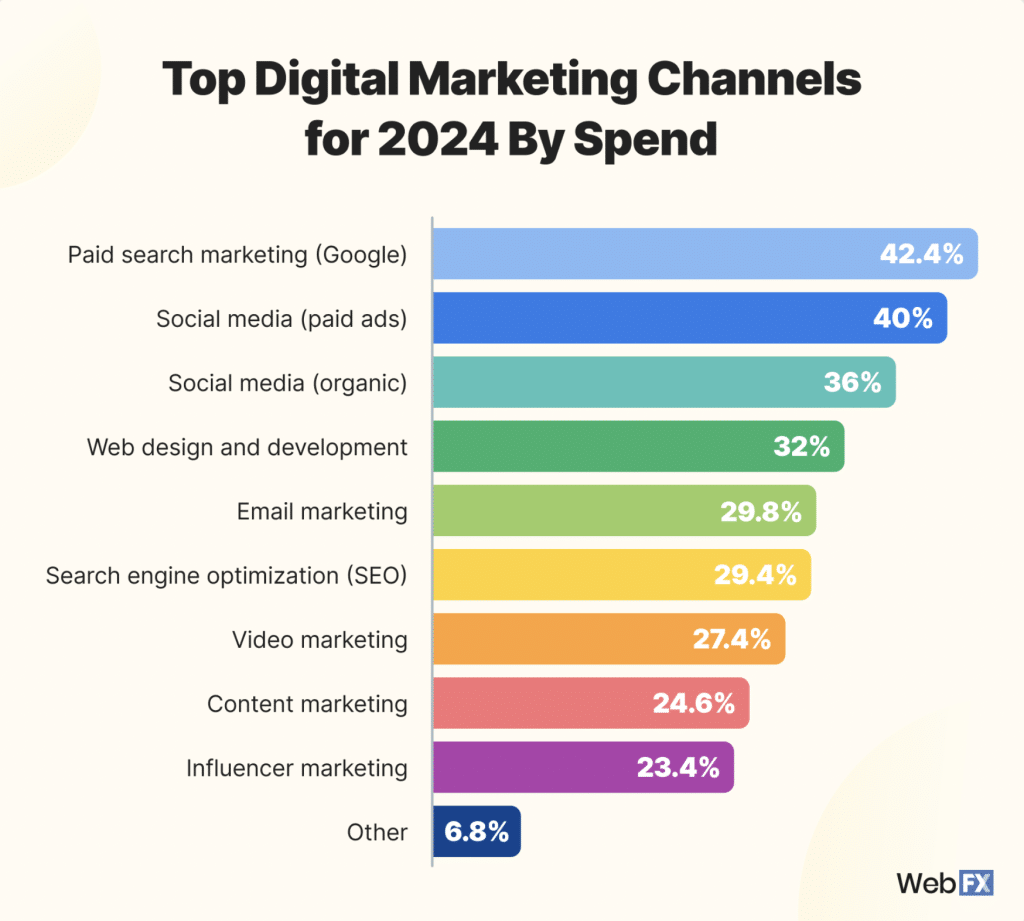
Image Source: Web FX
While the future of social media might come in the form of something, well, more social, the growth of these platforms is not likely to subside any time soon.
Social media will continue to make its presence known in every area of our lives and become truly integrated with both on and offline services.
In an episode of the dystopian Netflix series Black Mirror, social media has spilled out of the screen and into the real world as individuals rate their interactions with others and are awarded better housing, jobs, and social status based on their overall rating.
Science fiction? Maybe for now, but the future probably isn’t so far away. Most of the apps on your phone are probably already sharing data with your social media networks and it’s now common for employers and recruiters to screen social media profiles before interviews.
What does this mean for marketers? A deeper understanding of each customer as an individual and the opportunity to offer highly targeted offers and services, as the AI algorithms used in social media grow increasingly sophisticated.
The Rise of Micro-influencer Marketing
Influencer marketing has already grown huge in recent years with top influencers on platforms like Instagram and YouTube attracting millions of followers and making a six-figure income from their deals with brands.
However influencer marketing is still in its infancy and while it offers great ROI compared to more traditional advertising channels, there are some issues to be ironed out.
Fake followers are currently a problem that’s still being resolved, and there have been some notable occurrences when brand/influencer relationships have backfired in a bad way.
Big name influencers are also starting to lose their power as they take on more and more sponsored posts, reducing the authenticity and impact of their recommendations.
As consumers continue to value individual recommendations over being marketed at, it’s going to make sense to invest more in “micro-influencers” – those social media users who have a much smaller but dedicated following and can deliver truly authentic marketing messages to a trusting audience.
Influencers’ power will be measured not by the sheer number of followers they boast, but their personal relationships with each individual follower.
Augmented Reality Becomes Commonplace
Remember the Pokémon Go craze of 2016? The mobile game was not only a great example of how augmented reality can be used in video games, but also a marketing opportunity, as businesses jumped on the chance to sell to customers trying to catch a Pokémon or two on their doorstep.
Augmented reality is not just a fun gimmick for gamers. It’s being used more and more as a tool for brands to reach customers. In fact, 61% of customers are more likely to purchase items with businesses that have augmented reality services.
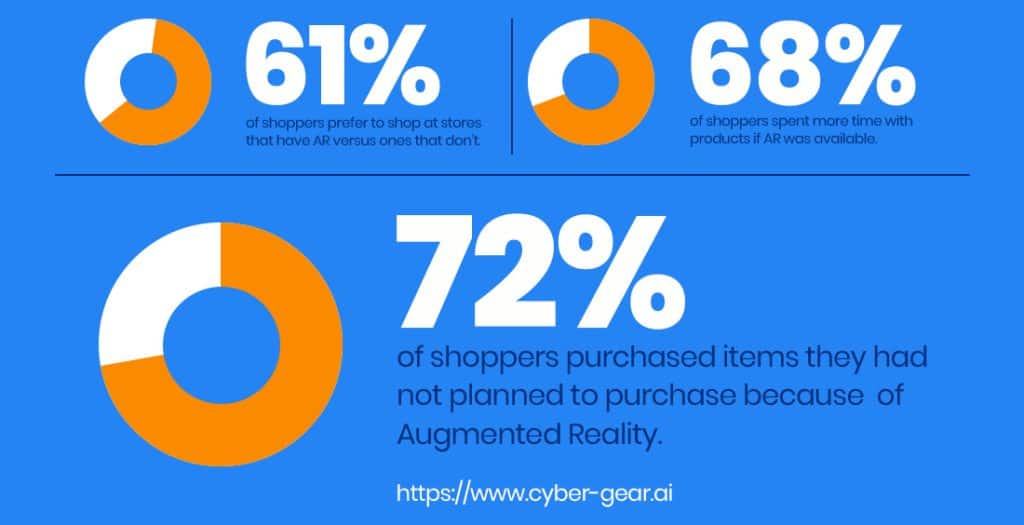
Image Source: CyberGear
Ikea now offers a virtual reality catalog where you can place pieces of furniture in your own home, and fashion brands are starting to use augmented reality to allow their customers to try on outfits virtually in the comfort of their own homes.
Expect to see more brands jumping on the augmented reality bandwagon, and the technology slowly becoming a more common occurrence with serious marketing goals, rather than a cute trick.
Video Overtaking All Other Digital Channels
Savvy marketers caught on to the power of online video a while back. Remember when The Washington Post threw out that prediction in 2015, saying video would be 80% of all online content by 2020? Well, we might not have hit that exact mark, but let’s be real, video has taken the digital world by storm. Especially live streaming – it’s been on a serious upswing, and the momentum hasn’t slowed down a bit.
Video Source: Easy Marketing
Here’s the scoop for 2024:
- YouTube isn’t just playing second fiddle to Google anymore; it’s a content powerhouse, with billions of views daily.
- Video content is now over 82% of all consumer internet traffic.
- Viewers claim they retain 95% of the information given in the form of videos.
- OptinMonster found that 72% of consumers prefer to learn about a product or a service through video content.
- Marketers land 66% more qualified leads through video marketing.
If your brand hasn’t dived deep into video marketing yet, you’re missing out. But it’s never too late to join the party. Live video mixed with a dash of augmented reality is making waves, creating experiences that are more immersive than ever. We’re talking about videos that not only tell a story, but put your audience right in the middle of the action.
So, as we move further into 2024, remember:
- Original and creative videos are where it’s at. They’re not just content; they’re experiences.
- Engagement through video is skyrocketing. If you’re not leveraging this, you’re playing catch-up.
Bottom line? Video marketing is the king of content in 2024. Don’t just dip your toes in. Dive in headfirst.
Going Back to Basics with Employee Activation
Of course all these advances in technology are very exciting, but we shouldn’t lose sight of the basic principles that make for a great marketing strategy, and a great company.
Employee activation will enable your organization to get the best out of every employee, who will act as ambassadors for your brand and grow sales and conversions in a genuine and authentic way that’s more effective than any advertising campaign could ever be.
We think this is the biggest B2B Marketing Trend right now!
Referring back to the trend of micro-influencer marketing, when your employees are engaged they will themselves act as micro-influencers for your company. If you are successful in employing individuals who align with your brand values and help their passion for what you’re trying to grow, they will act as your most dedicated cheerleaders.
As our reliance on technology grows, more and more organizations are also realizing they need to be more “human” and must activate the storytelling and organic sharing power of employees – this is the “paradox of AI” as we learn to take our place alongside machines in this brave new world of opportunities.
Outsourcing to Digital Marketing Agencies
Whether you’re a small business or a big one, you can generate more content by outsourcing to a digital marketing agency. Creating enough high-quality content with in-house resources is challenging and can hold you back from taking advantage of growth opportunities.
As the best way to rank on Google, digital marketing is significant to success. So why not outsource the help of marketing experts? 45% of small businesses already have a paid search strategy in place and numbers are expected to rise in 2024.
Help from educated professionals is often the difference between making little progress and seeing significant, continuous improvement in traffic and sales. Sit back, relax and watch your business grow this year by outsourcing to digital marketing agencies.
Where Do You Think The Future of Digital Marketing is Going?
As we glance back at the future of digital marketing for 2024, it’s clear that mastering these trends is key to staying ahead. From content marketing’s big comeback, the rise of AI-generated content, to leveraging employee creativity, these movements are reshaping our approach to digital engagement.
The future of digital marketing is about merging tech with human touch and innovation with insight. So, as we move forward, embracing these trends will not just help us connect with our audience, but truly resonate with them.
Ready to tackle the future of digital marketing? Check out our SEO Blog Writing Service or schedule a quick consultation to learn more about how Marketing Insider Group can help you earn more leads for your business.

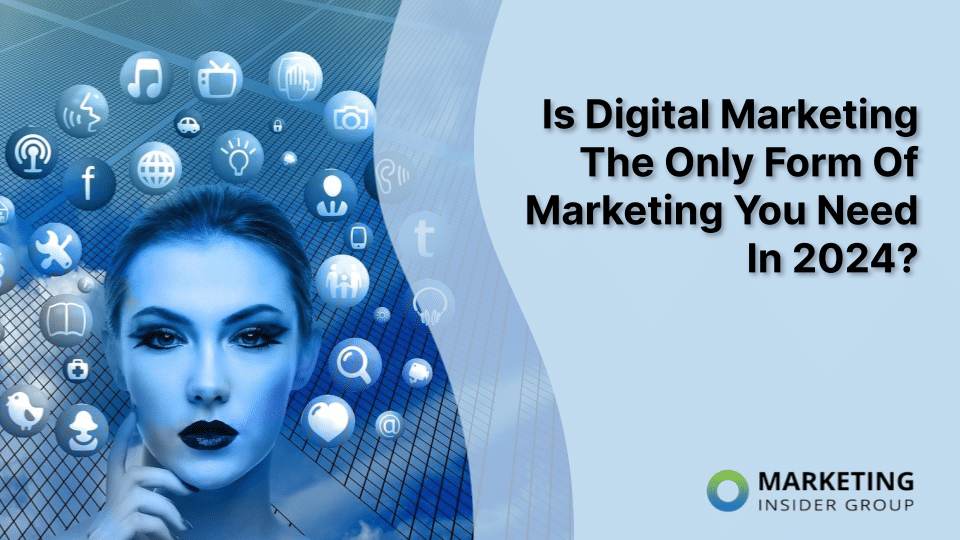
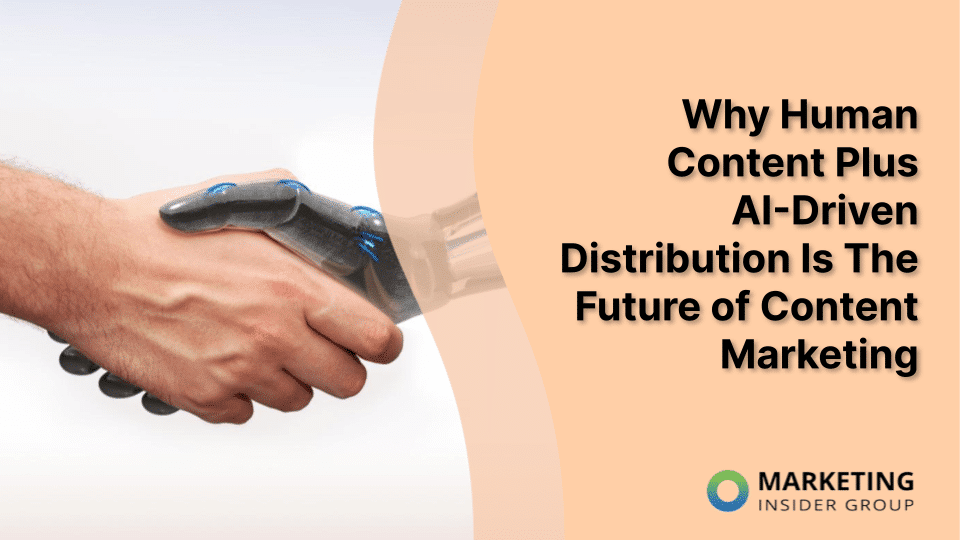




Hey
An Awesome Info!!!
It is very useful content for Digital Marketing People. Here they have advantages of certain various informative knowledge. Thank you for sharing your great knowledge with us.
Thanks, Michael!
Video marketing and using micro-influencers is something big to look out for in the coming years. Thanks for the heads up
Thanks, Jimmy!
Nice post, Michael. I think you’re right on the money about micro-influencers–consumers crave authenticity. And, how authentic can an influencer be if he/she is spread too thinly?
Thanks, Andrew! Great point!
Enlightening and affirming article. As for the micro influencers, it is all about scale for greater impact.
Agreed! Thanks, Mawarni!
Very good content. Thanks.
Nice article, Michael. I will especially look out for voice-powered devices, AI (which sometimes gives me the goose-pimples if I imagine how far they could go), what is happening in influencer marketing is somehting like “small is beautiful.” All I hope for isthat the micro-infleuncers are not going to be too expensive too.